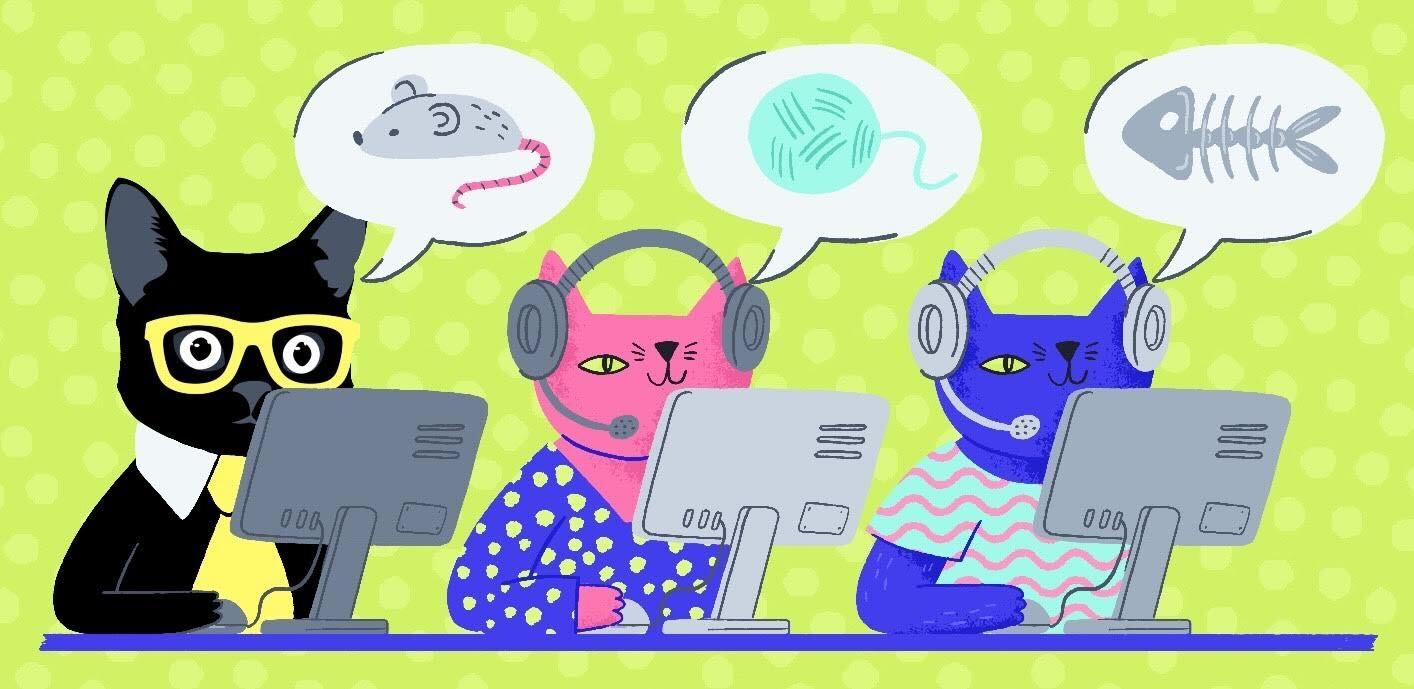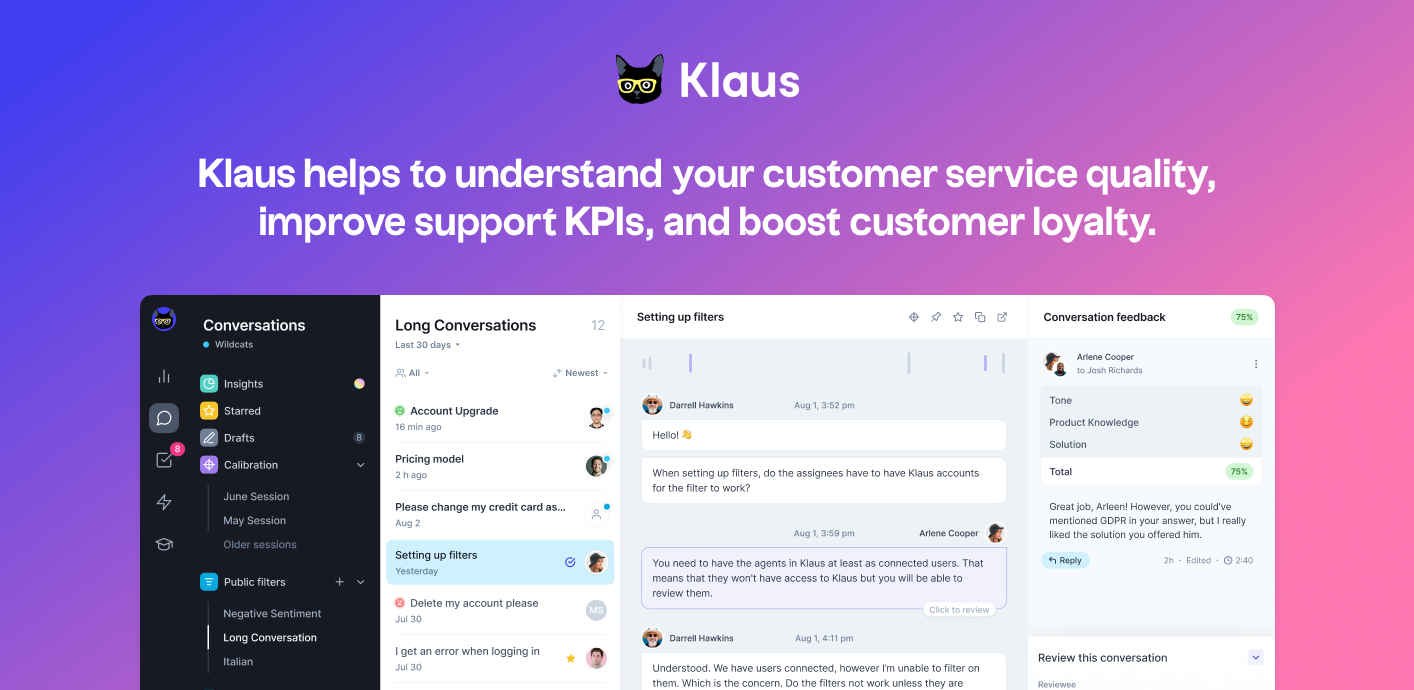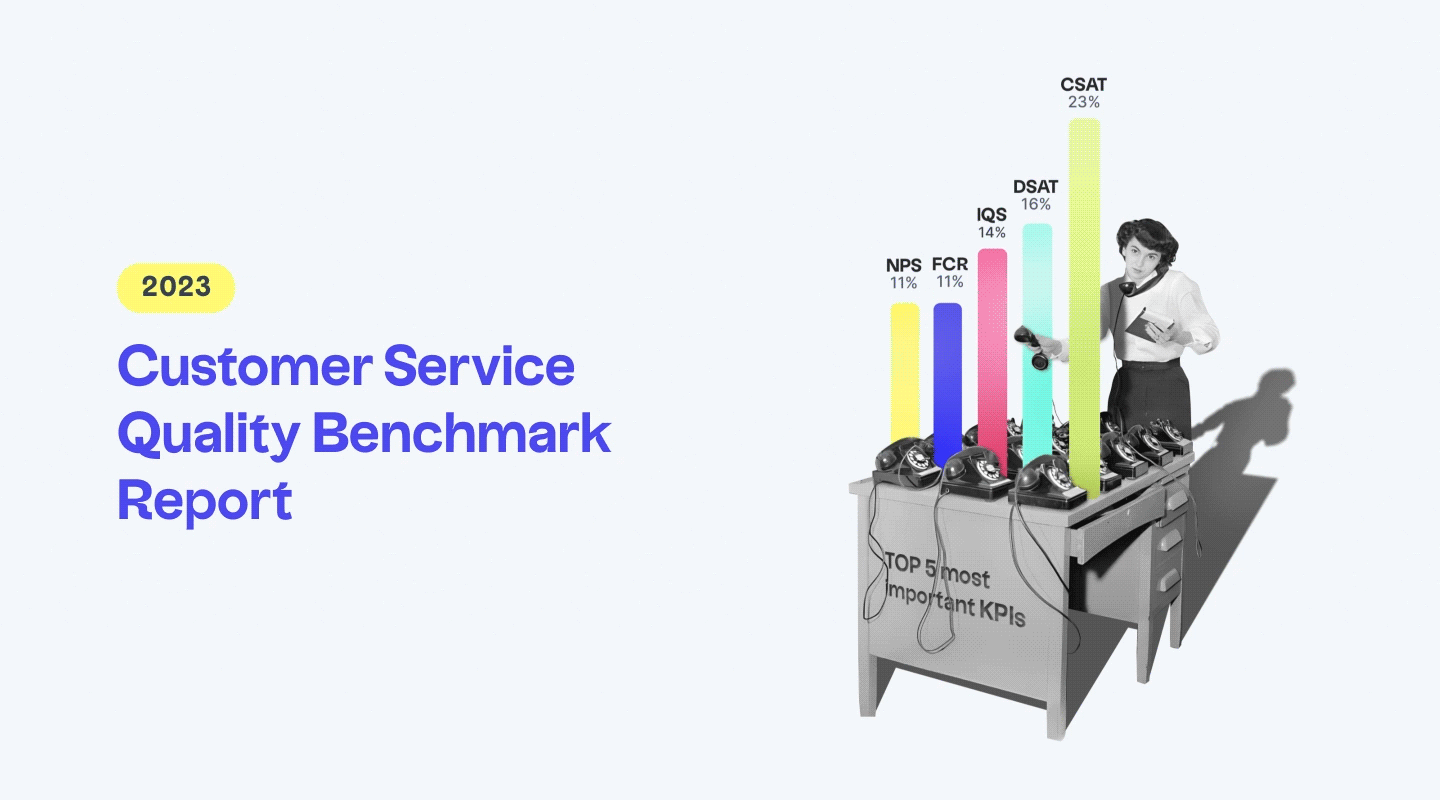Getting around in the customer service industry can sometimes feel like trying to speak a whole new language.
Customer service terms refer to the various concepts used in the field of support, which involves assisting customers before, during, and after a purchase or interaction with a company.
If you’re new to the industry or need a refresher, here are important customer service terms that you should know. With an explanation, of course!
Customer service terms: The basics

Support ticket
A support ticket is an interaction between a customer and a customer service agent. When a customer has a problem, question, or request, they can “open a new ticket”. The same thing happens when it’s an agent who reaches out first.
Such a support ticket contains details about the issue, and the customer’s information, and can be updated with progress notes as the team works to resolve the issue. By documenting every interaction, customer support teams can easily keep a record of individual requests, manage them efficiently, and ensure they’re resolved in a timely manner.
Support tickets come in different shapes and sizes, depending on the customer service channel.
Customer service channels
Customer service channels are the various methods through which customers can connect with a company’s customer support team. These channels provide customers with a platform to ask questions, express concerns, or get assistance with products or services.
Different customers prefer different support channels, so businesses typically offer several options to meet their customers’ needs.
✨ Most popular customer service channels channels
- 28.1% of companies primarily use Email
- 22.9% of companies primarily use Phone
- 14.4% of companies primarily use Social Media
- 13.2% of companies primarily use Chat
- 11.3% of companies primarily use Video
- 10.2% of companies primarily use SMS
Omnichannel support
Omnichannel support means offering consistent, good customer service across multiple channels. This includes email, phone, live chat, social media, and even in-person support.
There’s one thing to mention, though. Offering a few contact options doesn’t really equal having an omnichannel customer service strategy. When many companies say they provide an “omnichannel” customer experience, they often just mean “multichannel.”
Omnichannel customer support takes it up a notch by providing a smooth customer journey, no matter how customers reach out. In an omnichannel experience, the customer’s history and context go with them, from one customer service channel to another. This allows customer support agents to offer better, more purrr-sonalized help because they understand the whole story.

Proactive support
Proactive service is all about anticipating customer needs and addressing potential issues before they arise.
Instead of just waiting to respond whenever there’s an issue (in other words, providing reactive customer service), a customer support team can take matters into their own hands and reach out first. It might not seem like much, but a proactive customer service strategy can drastically improve customer experience.
Customer retention
Customer retention refers to a business’s ability to keep existing customers and encourage them to make repeat purchases.
By focusing on keeping existing customers, businesses can save on the costs of getting new ones and instead use those resources to improve customer experiences and build stronger relationships.
To measure customer retention, companies calculate the proportion of customers who remain loyal through consistently purchasing products or services.
(Number of retained customers / Number of customers at the beginning) x 100 = Retention Rate

Customer loyalty
Customer loyalty is a measure of a customer’s commitment or willingness to repeatedly choose a particular product, service, or brand over others. It represents a customer’s ongoing relationship with a company that goes beyond individual transactions, and it’s usually the result of a consistently positive customer experience, satisfaction, and the perceived value offered by the company.
Loyal customers not only purchase more frequently, but they also tend to be less price-sensitive and may even advocate for the brand, recommending it to friends and family, or sharing their positive experiences on social media. This is why businesses often invest significant resources in customer loyalty programs and customer retention strategies.
Customer churn
Customer churn, on the other hand, is the rate at which customers stop doing business with a company. Essentially, it shows how many customers were lost relative to the new customers gained in a specific time period.
All businesses lose customers from time to time. But keeping an eye on and reducing churn rate is important for growing one’s business:
(Number of customers lost in a given period of time / Number of customers at the beginning of the period) x 100 = Churn rate
By watching the percentage of customers that leave the business, companies can find any problems or things they need to get better at that might be affecting customer happiness. It’s a much better customer service strategy than just fighting customer loss with growth.

Customer service forecasting
Customer service forecasting is all about using past information, patterns, and number-crunching to anticipate future customer service needs.
It’s not talking about hazy crystal ball prediction. Forecasting is all about concrete, valuable projections for things like how many customer calls to expect or how many staff is needed on deck.
Customer feedback
Customer feedback is information provided by customers about their experiences with a company’s product, service, or overall performance. This feedback can come in many forms such as customer surveys, online reviews, social media comments, emails, or direct communication with the company.
Collecting feedback, be it paw-sitive or negative, can guide and shape products, services, processes, and support processes. Customer opinions yield valuable information about how they feel about the customer experience the brand brings, as well as indicate whether they’re satisfied with it.
Customer sentiment
Customer sentiment refers to the feelings, emotions, and attitudes that customers have towards a brand, product, or service. It’s essentially a measure of how customers perceive a business, which can be either positive, negative, or neutral.
Positive customer sentiment often correlates with higher customer loyalty and increased sales, while negative sentiment can indicate problems that need to be addressed to improve the customer experience.
To analyze customer sentiment, companies use various tools and methods. For instance, they might use customer reviews, social media comments, or survey responses. Advanced methods include using artificial intelligence (AI) or machine learning algorithms to analyze text and determine sentiment from written or spoken language.

Tone of voice
The tone of voice in customer service refers to the way a company’s service representatives communicate with its customers. It’s not about what they say, but how they say it.
A tone of voice can express a range of emotions and cat-titudes, from empathy and enthusiasm to professionalism and respect. Because of that, it can greatly impact customer experience. It can convey friendliness, empathy, and understanding, or it can express indifference or impatience. An appropriate and consistent tone of voice can help build trust and rapport with customers, making them feel valued and understood.
Support-driven growth
Support-driven growth is an umbrella term used to describe a business approach that shifts customer support from being — or being perceived as — a cost center to a critical revenue driver.
Rather than only focusing on reactively answering questions and solving problems, a growth-oriented customer support team tries to create additional value for customers within every support interaction. It’s an approach that directly impacts a company’s bottom line.
Customer support ROI
Customer Support Return on Investment (ROI) is a measure used by businesses to determine the financial returns they gain from their investment in customer support. It’s a ratio that compares the net profit or benefits gained from customer support efforts to the amount of money invested in these activities.
To calculate customer support ROI, a company would typically subtract the cost of their customer support operations (like salaries, software, and training) from the financial benefits gained (like increased sales or retained customers), then divide that number by the cost of customer support operations. The result is then multiplied by 100 to get a percentage.
A positive ROI means that the company is gaining more value from its customer support efforts than they are spending on it, which is the goal for most businesses.

SLA
A Customer Service Service Level Agreement (SLA) is a contract between a service provider (which could be an internal customer service department or an external company) and its customers that outlines the standard or level of service expected.
SLAs usually contain specific details about what the customer can expect in terms of the service’s quality, availability, and responsibilities. For example, it may state that customer support will respond to all inquiries within a certain time frame, say 24 hours, or that system uptime will be at least 99.9% of the time.
Breaches of the Service Level Agreement can have consequences, often detailed in the agreement itself. These could include things like credits for the customer, penalties for the service provider, or even termination of the contract in severe cases.
Customer service terms: Support quality
Businesses across the globe understand that every decent company needs a support department to take care of their customers and help them with their issues. However, there’s not much certainty when it comes to topics related to customer service quality.
High-quality customer service has a huge impact on business results. Excellent support can boost revenue and customer retention, while poor customer service experiences can only drive churn.
Customer service audit
A customer service audit aims to analyze and improve the quality of support operations. It involves evaluating various aspects of how a successful customer service team interacts with customers.
The exact items included in an audit can be different across organizations, but common things to review include tools and processes, customer feedback, team performance, and self-service resources like a knowledge base. The goal is to identify areas for improvement and make sure that customer service representatives are consistently meeting (or exceeding) customer expectations.

Customer service quality assurance
Customer service quality assurance is the practice of (regularly) monitoring the quality of customer interactions.
By monitoring and scoring all customer interactions, companies can identify and overcome their support weaknesses in the long run. Customer service quality assurance, support QA, and conversation (or ticket) reviews are essentially the same concepts, meant to assess how well the support agents’ responses meet the quality standards.
Customer service statistics that show the benefits of quality assurance:
- 76% of organizations agree that conversation reviews help improve customer satisfaction scores.
- 74% of customer support teams agree that conversation reviews help onboard new agents.
- 77% of teams agree that conversation reviews are useful for the support team members’ professional growth.
- 48% of teams use reviews to track IQS.
- 44% of teams use QA results in 1:1 feedback meetings.
- 42% of teams use quality assurance to measure the performance of customer service BPOs.
Conversation reviews
Just like with code reviews for software engineers or editorial reviews for writers, the goal of customer service reviews is to have an extra pair of eyes that analyze every interaction and provide feedback for improvements.
Conversation reviews come in many forms. They can vary by:
- Type: peer-to-peer reviews, manager reviews, QA agent reviews, self-reviews;
- Frequency: daily, weekly, monthly;
- Breadth: how many interactions are reviewed of total ticket volume;
- Complexity: informal verbal reviews, written reviews, using spreadsheets, or purpose-built software.
One thing is certain: Systematic conversation reviews are the only way customer-facing teams can learn to get the most out of all interactions with their users.
QA scorecard
A customer service QA scorecard is an evaluation form that helps to review customer conversations as objectively as possible. When done properly, QA scorecards speed up the review process while making feedback specific and measurable.
The trick is to build a QA scorecard in a way that best supports the company’s customer service goals, quality assurance standards, and customer expectations.

Customer service calibration
Customer service QA calibration is the process in which internal quality reviewers align their rating techniques to make sure that the entire customer support team receives receive the same level of feedback from all reviewers.
QA calibrations help reviewers synchronize their assessments, provide consistent feedback to support agents and eliminate bias from quality ratings. Every customer service rep should receive the same quality of feedback regardless of who reviewed their customer interactions.
Usually, the aspects that require quality assurance calibration are the following:
- Rating scale to check whether all reviewers understand the different ratings in the same manner. The larger the rating scale, the more important the calibration.
- Failed vs non-applicable cases — when a ticket was handled correctly but a specific aspect of the conversation was missing, reviewers might rate it differently.
- Free-form feedback AKA additional comments left to support reps, which are tricky to calibrate. Nonetheless, reviewers should agree on the “length” of feedback included in each review, feedback techniques used in the comments, and the overall style and tone.
Customer service terms: Technology
It’s difficult to agree that the quality and capabilities of customer service technology have a significant impact on both support agent & and customer experience, as well as contact center performance.
According to Customer Service Quality Benchmark Report, 70% of organizations plan to invest more in support automation. Rightly so.
Customer service automation
Customer service automation is the process of using technology to carry out certain aspects of support operations. Automated technology helps companies respond proactively to simple inquiries, manage data, and provide self-service options.
It is cost-effective, improves support team productivity, and is a wonder at collecting and managing data in a way that would be otherwise impossible.
When people think of how to automate customer service, they usually jump straight to chatbots. Chatbots are the most externally evident manifestation of automated support. However, there are many more automated customer service tools that can be overlooked.
Examples of customer service automation:
- Notifications of service/product disruptions, upgrades, new releases
- Surveys to collect customer feedback
- Regular assignments for manual quality reviews
- Reviewing tickets for 100% coverage
- Employee shift scheduling
- Data analytics
Self-service
Self-service refers to a support approach that empowers customers to find information and resolve issues on their own, without assistance from a customer support agent.
From a company perspective, it involves providing customers with tools, resources, and channels to help them access information and address their concerns independently. Typically, this includes FAQ sections, knowledge bases, online chatbots (including advanced AI-powered assistants), video tutorials, and Interactive Voice Response (IVR) systems. Calculating the self-service ratio will then depend on the tools offered.

IVR
Interactive Voice Response (IVR) is a technology used in call centers that allows a computer to interact with humans through the use of voice and DTMF tones input via a keypad.
In other words, IVR allows customers to interact with a company’s phone system via voice commands or by pressing numbers on a keypad. This technology can be used to control almost any function and the interface can be broken down into a series of simple menu choices.
Once the IVR system is set up, it can help route calls to the appropriate department, provide answers to common questions, and even complete certain tasks like making payments or scheduling appointments without human assistance. It can greatly increase the efficiency of a customer service department by ensuring that only the calls requiring human interaction are passed on to live agents.
Customer service/help desk software
Help desk software keeps track of all customer requests across various channels (be it social media, phone calls, emails, and live chats) making it convenient for a customer support team to address them in a timely manner and manage customer support workflows.
Some trustworthy help desk vendors include:
Quality assurance software
Quality assurance solutions (also called Quality Assurance, QA, or Quality Control software) are crafted to help companies evaluate and improve their customer service team’s performance. Some of the best customer support software under this category include:
- Zendesk QA (formerly Klaus)
- EvaluAgent
- Scorebuddy
- Playvox
- MaestroQA

AutoQA
AutoQA is short for automated quality assurance. By automatically assessing support tickets, AutoQA means 100% coverage and a complete, unbiased overview of customer interactions. It takes into account multiple categories and languages to handle huge ticket volumes in less time.
Manually reviewing conversations to find problem areas is like taking a metal detector to the beach for treasure. It’s pretty long and tiring, with no guarantee of a result. AutoQA reduces labor and helps you improve your customer service quality faster than you’ve ever been able to before.
However, always remember that there is no absolute binary between automated and manual. The human in the loop (a QA specialist) is what brings to light the enhancements of automation and AI.
Customer service terms: Metrics & KPIs
Providing exceptional support is no longer an option but a necessity. As a result, teams must track and analyze the right customer service metrics to ensure their teams are meeting these expectations.
It’s tough not to become so entwined with the numbers that you cannot see the forest for the trees. Fur-miliarize yourself with the acronyms and calculations to decipher which are most relevant to you and your goals — and get inspired by other customer service teams:

Metrics tracked by support teams according to the Customer Service Quality Benchmark Report
CSAT
Customer Satisfaction Score (CSAT) measures how well a company, its products, support, and other business services meet its users’ expectations.
CSAT is measured at the individual level, meaning that users are questioned separately (How satisfied are you with the product/service/support received?), and sometimes anonymously.
The results, however, are averaged out to give a composite Customer Satisfaction Score. CSAT is usually expressed as a percentage: 100% being total customer satisfaction, and 0% total customer dissatisfaction.
The rating scale can be as simple as a choice between thumbs up and thumbs down, though is usually more granular.
IQS
Internal Quality Score (IQS) is a customer service metric that shows how well a customer support team is performing based on internal quality standards set by a company. To track IQS, support conversations have to be reviewed and scored against predefined categories (written on a QA scorecard)
To calculate the IQS score for a single conversation, all the ratings have to be summed up and divided by the maximum available score multiplied by the total number of categories. Then, the process has to be repeated with a representative sample of support tickets to calculate IQS for the entire customer service team.
(Sum of ratings / [Maximum available score x Number of categories]) x 100 = IQS (%)
NPS
NPS stands for “Net Promoter Score.” It is a metric that companies use to understand how likely their customers are to recommend their product or service to others.
Tracking the Net Promoter Score is based on a simple customer survey: On a scale of 0-10, how likely are you to recommend our product/service to a friend or colleague?
Based on the responses, customers are categorized into three groups: Promoters (9-10), Passives (7-8), and Detractors (0-6). The Net Promoter Score is then calculated by subtracting the percentage of Detractors from the percentage of Promoters. The resulting number ranges from -100 to 100, with a higher score indicating a higher likelihood of customer recommendation.
([Number of Promoters – Number of Detractors] / Number of total responses) x 100 = NPS (%)

FRT
FRT, meaning First Response Time, indicates how long customers have to wait before getting an initial response from a support rep after submitting an inquiry — typically via email, phone, or live chat.
To calculate FRT, the total First Response Time for all tickets received has to be divided by the number of interactions in a desired time frame.
Total first response time for all tickets received / Total number of interactions = Average FRT
Unless the support coverage is 24/7, the Average First Response Time is best measured during business hours, so that it isn’t affected by requests received on nights or weekends.
When using help desk software, companies should be able to easily access these numbers in the reporting features.

FCR
FCR (First Contact Resolution Rate or First Call Resolution Rate) tracks support requests that were solved during the first customer interaction.
First Contact Resolution Rate can be calculated for different support streams (such as phone, email, or live chat), and for different types of inquiries. Typically, it’s used in call centers to measure the percentage of customer calls that were resolved on the spot, without the need to follow up.
The formula for calculating FCR:
(Number of inquiries resolved on first contact / Total number of inquiries received) x 100 = FCR %
It’s important to note that not all tickets are FCR-eligible, though. For example, sometimes customers make mistakes in their inquiries and it just isn’t possible to fix their problems at the first attempt.
CES
Customer Effort Score (CES) is a support metric that reflects the amount of effort customers have to put in to get a resolution to their inquiry.
It is measured by asking customers to rate whether they agree with a statement like: “Your company made it easy for me to handle my issue.” A common method is to use a scale from 1 to 7, where 1 means “It was very difficult” and 7 means “It was very easy”. The ratings are collected, added up, and then divided by the total number of responses. The result is an average Customer Effort Score.
Total sum of responses / Number of responses = Customer Effort Score (CES) score
The lower the average CES, the harder it was for customers to get their issues resolved. On the other hand, a higher average Customer Effort Score means that the support team is doing a great job at reducing customer effort and making things easy for your customers.

DSAT
Customer Dissatisfaction Score (DSAT) measures the percentage of customers who are dissatisfied with a company, its products or services, or the support offered.
The definition of “dissatisfied customers” can vary by company, depending on how granular the rating scale is. For a 7-point scale, for example, 1, 2, and 3 can be treated as indicators of dissatisfied customers.
It’s measured at the individual level, meaning that users are questioned separately (and sometimes anonymously). The results, however, are averaged out to give a composite Customer Dissatisfaction Score, usually expressed as a percentage.
(Number of negative responses / Number of total responses) x 100 = DSAT %
AHT
Average Handle Time (AHT) is the average amount of time that a customer service representative spends handling a customer interaction.
The handling time refers to all the tasks involved in the interaction — greeting the customer, collecting information, resolving the problem, and completing any documentation or work after the conversation.
Knowing the average time it takes to handle customer interactions can help companies gauge customer satisfaction and optimize resources to meet demand without long wait times. Generally, the lower the Average Handle Time, the more contacts a customer support agent can work through.
Total time spent on resolving conversations / Total number of conversations = AHT
Ticket Volume
Ticket Volume (also referred to as Total Tickets or Conversation Volume) tracks all customer queries that happen across channels. Think about all the phone calls, emails, chat sessions, and social media messages received.
Emails + Phone calls + Live chat sessions + Social media messages = Ticket Volume
These inquiries can be anything from a general question to a complex technical problem that requires a support agent’s attention. Over time, as customer demand for a business grows, the volume of tickets is likely to increase too.

Escalation Rate
Customer escalation management is the process a case goes through once something happens that makes it escalate — that is, the issue is not resolved by the first-line agent but moves to someone more senior.
In an ideal world, all support tickets should be resolved with a single response. However, every now and then customer service agents face cases that need more interaction. Escalation Rate shows how many support tickets escalated to seniors/managers, and were not solved by first-line support agents.
Escalated support tickets / Total number of tickets = Escalation Rate
If this percentage is low, that means the first person the customer talks to is usually able to solve the customer’s problem.

Customer service benchmarking
Customer service benchmarking is the process of measuring a company’s customer service performance and comparing it with the performance of other companies or industry standards. This process helps businesses understand where they stand in comparison to others in terms of customer service excellence.
This can be done in a variety of ways. Some companies may compare their performance against industry-wide metrics or standards, while others may choose to benchmark against a select group of top-performing competitors.
The goal of customer service benchmarking is not just to see how a company stacks up against others, but also to identify areas where they can improve. By understanding what top performers do well, companies can learn valuable lessons and make necessary changes to enhance their own customer service experiences.
Customer service lingo explained
Armed with these essential customer service terms, you’re well-equipped to navigate the intricate world of customer support with confidence and ease. Remember, effective communication is at the heart of exceptional customer service, and understanding key terms in this customer service glossary will help you deliver top-notch support.
Keep in mind that customer service terminology is not static; it evolves along with the ever-changing landscape of customer expectations and technology advancements. So, staying updated on emerging trends and new customer service terminology is crucial to staying ahead in the field.




